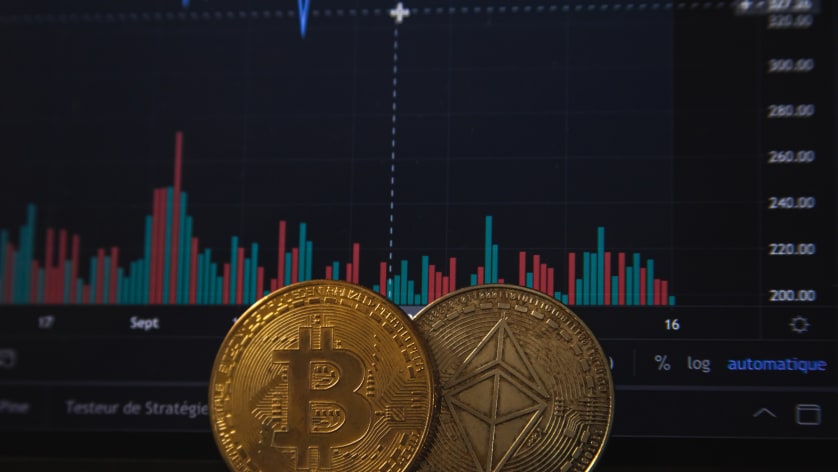What is Blockchain?

Blockchain is a decentralized and distributed ledger that stores the record of ownership of digital assets like cryptocurrencies, but also other assets. The data stored on the blockchain is unalterable, making it a rather secure protocol for payments, healthcare and cybersecurities.
Overview
Decentralization and cryptographic hashing make the history of any digital asset unalterable and transparent through blockchain technology.
Blockchain technology operates through a decentralized distribution system, similar to how a Google Docs document is shared. No one is locked out and awaiting changes from another party while all modifications to the document are being recorded in real-time; making changes completely transparent. A significant gap to note is that, unlike Google Docs, original content and data on the blockchain cannot be modified once written; adding to its level of security.
Although blockchain technology is more complicated than a Google Doc, the analogy still holds true to illustrate key concepts of the technology:
BLOCKCHAIN MEANING
A blockchain is a digital ledger or database where blocks of digital asset data are stored and chained together, forming a chronological source-of-truth for the data.
Unlike physical assets, digital assets are not copied or transferred, but instead are distributed.
The decentralization of digital assets allows for real-time accessibility, transparency and governance amongst more than one party.
The transparency of blockchain ledgers – any changes made are documented, preserving integrity and trust.
The security measures inherent in blockchain technology make it an ideal choice for nearly every industry.
Why Is Blockchain Important?
Blockchain is an especially promising and revolutionary technology because it helps reduce security risks, stamp out fraud and bring transparency to a large scale.
Originally associated with cryptocurrency and NFTs in the 2010s, blockchain technology has since become a versatile management solution for global industries. Today, examples of blockchain technology include providing transparency for the food supply chain, securing healthcare data, innovating gaming and overall changing how we handle data and ownership on a large scale.
How Does Blockchain Work?
The three key concepts of blockchain are: blocks, nodes and miners.
What Is a Block?
Chains are made of multiple blocks, and each block has three components:
- Data in the block
- A nonce is a 32-bit number that is generated when a block is created.
- A hash in blockchain is a 256-bit number that is permanently attached to the nonce.
- When a new chain is started, the first block is generated by a nonce. This nonce produces a cryptographic hash that signs and links the data in the block to itself. The data can be unbound from the nonce and hash if it is mined.
What Is a Miner in Blockchain?
Miners generate new blocks on the blockchain through a process called mining.
Every block in a blockchain has a unique nonce and hash, and also references the hash of the previous block in the chain. This makes mining a block very hard, especially on big chains.
Miners use special software to solve the complex math problem of finding a nonce that generates an accepted hash. Because the nonce is only 32 bits and the hash is 256, there are roughly four billion possible nonce-hash combinations that must be mined before the right one is found. When that happens miners are said to have found the "golden nonce" and their block is added to the chain.
The reason it is so "safe" is because it would take an enormous amount of time and computing power to find the golden nonce for just one block, let alone all of the blocks that come after it.
A successful mining of a block results in the network accepting the change and the miner being rewarded financially. The main benefit of using a blockchain is that it lets people share valuable data securely, without having to worry about it being tampered with.
What Is Decentralization in Blockchain?
One key aspect of the blockchain is decentralization. One computer cannot have 100% control over the chain. The nodes provide a distributed ledger in connection with the chain. Nodes are electronic devices that keep the network functioning by keeping copies of the chains.
Blockchains are transparent ledgers of all actions that can be easily checked and viewed by every participant, who is given a unique alphanumeric identification number.
The combination of public information with a system of checks and balances helps the blockchain maintain integrity and creates trust among users. In essence, blockchains can be thought of as the scalability of trust via technology.
HOW BLOCKCHAIN WORKS
The blockchain is a digital register, composed of encrypted units of information which are "chained" together and verified by complex mathematical formulas.
It is almost impossible to change the math problems involving matching nonces and hashes at a later date — the record of previous actions on the blockchain is highly accurate and secure, making manipulation very difficult.
The blockchain is a digital ledger that stores data in a decentralized manner, ensuring that no one organization can own or manipulate it.
BLOCKCHAIN USES
The versatility of blockchain technology has made it useful in a number of industries beyond financial transactions. Its secure and transparent properties have a range of applications in areas such as energy, logistics, education, and more.
TOP BLOCKCHAIN APPLICATIONS
- Cryptocurrency
- Cybersecurity
- Accounting and record keeping
- Supply chain
- Healthcare
Cryptocurrency: Blockchain vs Cryptocurrency
The blockchain's most popular use are cryptocurrencies. The biggest among them Bitcoin and Ethereum. Cryptocurrencies are digital currencies (tokens) used to purchase things in the internet. It is just like cash in a bank account, with more volatile prices. Unlike cash, cryptocurrencies act both as a public ledger and an enhanced cryptographic security system. Online transactions are therefore always recorded and secured. The myth of Bitcoin being untracable is hereby not really true.
The term "Bitcoin" is often used to refer to both the blockchain technology and the cryptocurrency, but they are two distinct entities. The first blockchain application appeared in 2009 as Bitcoin, a crypto system that uses distributed ledger technology. This event also marked Bitcoin as the first "blockchain." The aspect of blockchain that is being used to house this new digital currency is what brought both entities into association, and what led them quickly into the spotlight. The Bitcoin blockchain describes only the technology in which the currency is housed, while the Bitcoin cryptocurrency describes only the currency itself.
HOW DOES CRYPTO WORK?
Cryptocurrencies are digital currencies that use blockchain technology to record and secure every transaction. A cryptocurrency like Bitcoin can be used as a digital form of cash to pay for everyday items as well as larger purchases, like cars and homes. You can buy Bitcoin using one of several digital wallets or trading platforms, then digitally transfer it upon purchase of an item. The blockchain records the transaction and the new owner. The appeal of cryptocurrencies is that everything is recorded in a public ledger and secured using cryptography, making an irrefutable, timestamped and secure record of every payment.
To date, there are more than 18,000 cryptocurrencies in the world that have a total market capitalization around $2 trillion. Bitcoin holds the majority of the value for these tokens.
Here are some of the primary causes of cryptocurrency's recent boom:
The security of blockchain technology makes it much harder to commit theft, as each cryptocurrency has its own unique and identifiable number that is linked to a single owner.
Crypto eliminates the need for personalized currencies and central banks. With blockchain, crypto can be transmitted to anyone, anywhere in the world without the requirement for currency exchange or without obstruction from central banks.
Some people have become rich by investing in cryptocurrencies. However, it is speculated that these investors are only driving up the prices temporarily and do not have the long-term benefits of crypto in mind.
In February 2021, Tesla announced that it would invest $1.5 billion into Bitcoin and begin to accept it as payment for their cars. However later, Tesla revoked that claim and sold a lot of their Bitcoin for profit, creating even more volatile prices for cryptocurrencies that time.
Some argue that the lack of regulation in the crypto market is a major downside, but others believe that the benefits of crypto outweigh this risk. Crypto is known for its volatility, which has led to some investors becoming very wealthy, while many others have lost significant amounts of money.
Whether digital currencies are the future or not is yet to be seen. However, it looks as if blockchain’s recent growth is more rooted in reality than simply being hype. Although blockchain is still relatively new and uncharted territory, it shows potential for things beyond Bitcoin.
Beyond Bitcoin: Ethereum Blockchain
The development of the Ethereum blockchain can be traced back to a number of areas where the technology's transparency and security has seen growing adoption, much of which is a result of blockchain's original intended purpose for Bitcoin.
In 2013, Russian-Canadian developer Vitalik Buterin published a white paper that proposed a platform combining traditional blockchain functionality with one key difference: the execution of computer code. This gave birth to the Ethereum Project.
The Ethereum blockchain today enables developers to create sophisticated programs that communicate with one another through the blockchain itself.
Just as with Bitcoin, it is worth mentioning that the Ethereum blockchain and the Ethereum cryptocurrency are two distinct entities.
Tokens
Ethereum programmers can create tokens to represent any kind of digital asset and execute its functionality according to a set of programming instructions.
NFTs have grown in popularity in recent years due to their ability to store digital media like videos, music, and art.
Blockchain technology is being researched and developed by thousands of companies in order to be used in a variety of different sectors.
Blockchain is disrupting the current status quo of innovation by letting companies experiment with cutting-edge technology like peer-to-peer energy distribution or decentralized forms for news media. Much like the definition of blockchain, the uses for the ledger system will only evolve as technology evolves.
Blockchain Applications for Industries
Blockchain technology is being used in many different ways, not just for cryptocurrency.
The capabilities of blockchain technology are growing, and all the possible applications of blockchain are yet to be discovered.
BLOCKCHAIN HISTORY
The following is a brief timeline of some of the most important and notable events in the development of blockchain technology.
Blockchain Evolution
The concept of blockchain was first introduced in 1991 by Stuart Haber and Wakefield Scott Stornetta, who proposed the idea of a cryptographically secured chain of records, often referred to as blocks. In 2008, Satoshi Nakamoto gave blockchain technology an established model and planned application, which marked a pivotal point for the technology. The first cryptocurrency and blockchain were launched in 2009, starting the impact of blockchain across the tech sphere.
2008
The individual or group known as Satoshi Nakamoto releases "Bitcoin: A Peer to Peer Electronic Cash System."
2009
The first recorded BTC transaction occurs between computer scientist Hal Finney and the unknown Satoshi Nakamoto.
2010
Laszlo Hanycez, a Florida-based programmer, made the first ever purchase using Bitcoin on May 22, 2010 — two Papa John's pizzas for 10,000 BTC, worth around $60 at the time.
2011
The Electronic Frontier Foundation, Wikileaks, and other organizations are beginning to accept Bitcoin as donations.
2012
Bitcoin Magazine, launched by early Bitcoin developer Vitalik Buterin, is a popular source for information on cryptocurrency and blockchain technology.
2013
Bitcoin market capitalization reaches 1 billion dollars, making Bitcoin worth 100$ for the first time. Vitalik Buterin releases his “Ethereum Project” paper suggesting lots of possibilities for Crypto besides BTC.
2014
Zynga, The D Las Vegas Hotel and Overstock.com start accepting BTC as payment. The Ethereum Project raises 18 million dollars in BTC via crowdfunding. R3, a collective of 200+ blockchain companies form new blockchain projects to implement into new technology.
PayPal announces Bitcoin integration and the first NFT is minted.
2015
Over 100.000 shops accept BTC. NASDAQ and San-Francisco blockchain company team up, testing blockchain technology for trading stocks in private companies.
2016
IBM announces a blockchain strategy for business solutions. The Japanese government recognizes the validity of the blockchain technology and cryptocurrencies.
2017
BTC first reaches 1000 dollars, making the market cap reach 150 billion dollars. Wall Street trader and JP Morgan CEO Jamie Dimon exclaims his belief in blockchain as a technology and gives the ledger system a vote of confidence.
Bitcoin reaches a high of 19.783,21 $. Dubai announces that it's government would be blockchain powered by 2020.
2018
Facebook hints at possibly creating its own currency. IBM develops a blockchain based banking platform with banks like Citi and Barclays joining.
2019
China's President Xi Jinping publicly shows his support for blockchain as the country's central bank announces its plans to develop a cryptocurrency.
Jack Dorsey, the CEO of Twitter and Square, has announced that the company will be hiring blockchain engineers to work on its future crypto plans.
The New York Stock Exchange (NYSE) has announced the creation of Bakkt - a digital wallet company that will offer cryptocurrency trading.
2020
BTC almost hits 30.000 dollars.
PayPal claims to let people buy, hold and sell crypto. The Bahamas launch world's first central bank digital currency, known as “Sand Dollar”.
Blockchain has become a key player in the fight against COVID-19, due to its ability to securely store medical research data and patient information.
2021
BTC market capitalization passes 1 trillion dollars. Web3 increasingly gains popularity.
El Salvador accepts Bitcoin as legal tender, as the first nation.
Tesla purchases 1.5 billion dollars in BTC and starts accepting it as a form of payment. The metaverse rises, a virtual environment building in blockchain technology, gains attention and starts growing.
BTC all-time high is reached at 69.045 dollars.
2022
Cryptocurrencies lose 2 trillion dollars in market value because of inflation and rising interest rates. Google's Digital Assets Team is launched to provide customer support on blockchain programs.
UK goverment proposes safeguard for stablecoin holders.
Minecraft bans NFT and blockchain technology use in the game.














